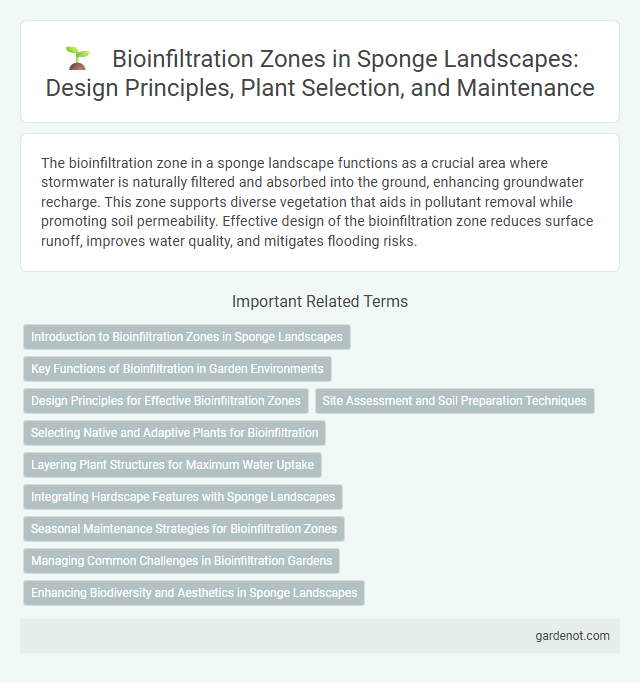The bioinfiltration zone in a sponge landscape functions as a crucial area where stormwater is naturally filtered and absorbed into the ground, enhancing groundwater recharge. This zone supports diverse vegetation that aids in pollutant removal while promoting soil permeability. Effective design of the bioinfiltration zone reduces surface runoff, improves water quality, and mitigates flooding risks.
Introduction to Bioinfiltration Zones in Sponge Landscapes
Bioinfiltration zones in sponge landscapes are designed to mimic natural hydrological processes by facilitating the infiltration and filtration of stormwater through engineered soil media. These zones enhance groundwater recharge and reduce surface runoff, effectively managing urban water cycles while improving water quality by removing pollutants. Integrating bioinfiltration zones supports ecological resilience and promotes sustainable urban drainage systems by restoring natural water flow patterns.
Key Functions of Bioinfiltration in Garden Environments
Bioinfiltration zones in garden environments enhance stormwater management by promoting natural infiltration and reducing surface runoff through engineered soil media and vegetation. These zones filter pollutants, including nutrients, heavy metals, and sediments, improving water quality before it enters groundwater or adjacent water bodies. Their ability to retain moisture supports plant growth and sustains ecosystem health, contributing to resilient and sustainable landscape design.
Design Principles for Effective Bioinfiltration Zones
Effective bioinfiltration zones prioritize soil permeability, vegetation selection, and hydraulic design to maximize stormwater absorption and pollutant removal. Using native plants with deep root systems enhances soil structure while facilitating water infiltration and nutrient uptake. Properly sized zones with layered soil media prevent clogging and promote sustainable groundwater recharge in sponge landscape systems.
Site Assessment and Soil Preparation Techniques
Bioinfiltration zones in sponge landscapes require thorough site assessment involving soil permeability tests and topographical surveys to ensure optimal water infiltration and storage capacity. Soil preparation techniques include removing compaction, amending soil with organic matter, and grading to facilitate runoff capture and percolation. Proper evaluation of existing vegetation and subsurface conditions enhances the design and functionality of bioinfiltration systems.
Selecting Native and Adaptive Plants for Bioinfiltration
Selecting native and adaptive plants for the bioinfiltration zone enhances stormwater management by optimizing water absorption and pollutant removal. These plants, such as sedges, rushes, and deep-rooted grasses, thrive in local soil conditions and promote soil stabilization while supporting biodiversity. Incorporating species with high tolerance to fluctuating moisture levels ensures long-term functionality and resilience of the sponge landscape system.
Layering Plant Structures for Maximum Water Uptake
Layering plant structures in the bioinfiltration zone enhances water uptake efficiency by combining deep-rooted species with surface-covering plants, facilitating optimal infiltration and absorption. Root systems of varying depths increase soil permeability, promote nutrient cycling, and reduce surface runoff in sponge landscape applications. Integrating native grasses, shrubs, and perennials maximizes evapotranspiration, improving overall water management and resilience during heavy rainfall events.
Integrating Hardscape Features with Sponge Landscapes
Integrating hardscape features such as permeable pavements, bioswales, and rain gardens within bioinfiltration zones enhances the sponge landscape's ability to manage stormwater effectively. These elements facilitate filtration and slow runoff, promoting groundwater recharge and reducing urban flooding risks. Optimizing this synergy supports sustainable urban drainage systems while maintaining aesthetic and functional public spaces.
Seasonal Maintenance Strategies for Bioinfiltration Zones
Seasonal maintenance strategies for bioinfiltration zones in sponge landscapes include regular removal of debris and sediment buildup to ensure optimal infiltration rates during wet seasons. Inspecting and replenishing vegetation with native plants enhances soil stabilization and pollutant uptake throughout seasonal changes. Adjusting maintenance frequency based on rainfall patterns and temperature fluctuations helps maintain the bioinfiltration zone's efficiency and longevity.
Managing Common Challenges in Bioinfiltration Gardens
Bioinfiltration zones in sponge landscapes effectively manage stormwater by filtering pollutants and enhancing groundwater recharge, yet challenges such as clogging, compaction, and vegetation stress require strategic maintenance. Proper soil composition with high permeability, regular sediment removal, and selection of resilient native plants are critical for sustaining infiltration rates and plant health. Implementing adaptive management practices, including seasonal monitoring and adjusting irrigation, ensures optimal bioinfiltration performance and long-term ecological benefits.
Enhancing Biodiversity and Aesthetics in Sponge Landscapes
Bioinfiltration zones in sponge landscapes significantly enhance biodiversity by creating habitats for diverse plant and animal species, promoting ecological balance. These zones filter stormwater naturally, improving water quality while supporting native vegetation that attracts pollinators and wildlife. Integrating bioinfiltration features contributes to the visual appeal of green spaces, blending functional sustainability with aesthetic value.
Bioinfiltration zone Infographic

 gardenot.com
gardenot.com